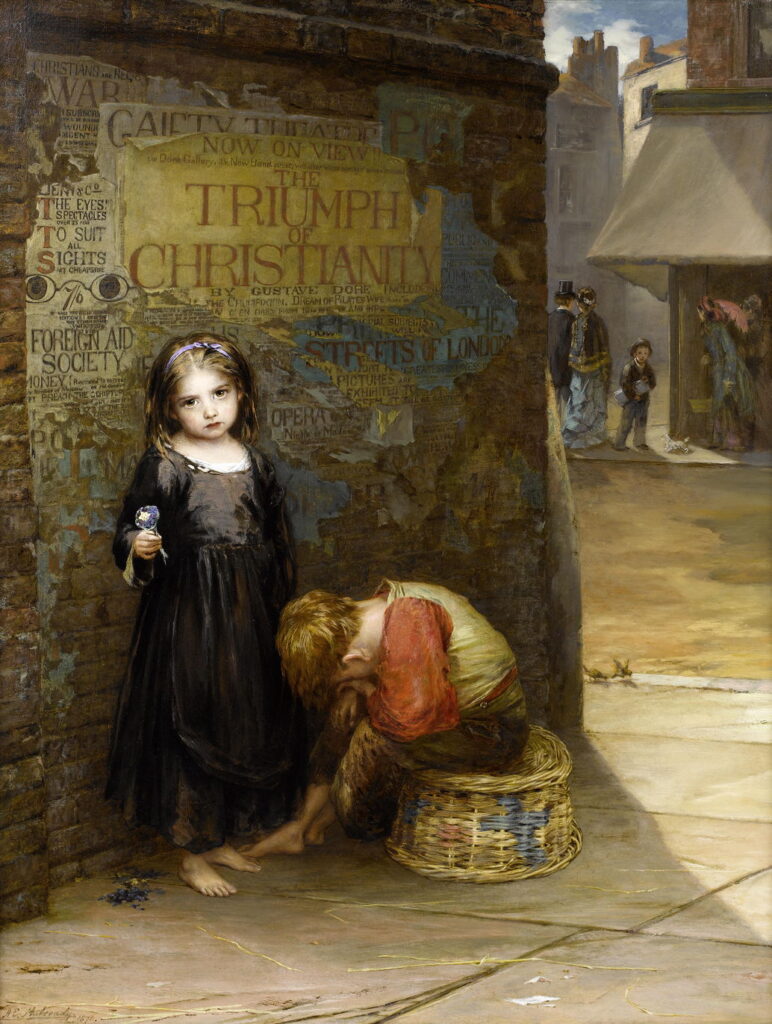Reading Visual Art: 187 Poster, messages

No one knows when people started attaching big sheets of paper to walls as posters, but it wasn’t until large-format colour printing became popular in the middle of the nineteenth century that the modern poster became commonplace. Within a couple of decades walls in many public places became covered with announcements, particularly those promoting events and products, and the advertising industry developed. In this week’s two articles about the reading of paintings, I show examples of the use of posters in paintings, and how their contents can be relevant.
Richard Dadd (1817–1886), Sketch to illustrate the Passions: Want (1856), watercolour, dimensions not known, Victoria and Albert Museum, London. Image courtesy of and © Victoria and Albert Museum, London.
One of the earliest examples of a poster contributing to the reading of a painting is one of Richard Dadd’s watercolour series of the Passions, in Want, the Malingerer dated 26 November 1856. From a hill overlooking the River Medway at Chatham, where Dadd was born and brought up, he shows a small family of destitutes. The father, his face hidden behind a poster seeking a “good Christian home to a poor forlorn outcast”, appears to be a military veteran, has a couple of crutches, and bare feet. The mother, her face aged beyond her years, is slumped in her tattered clothing, her right hand stretched out, its wrinkled palm seeking charity. Behind them is their son, and beyond the father their dog holds a tin begging bowl in its mouth.
Augustus Leopold Egg (1816–1863), Past and Present, No. 3 (1858), oil on canvas, 63.5 x 76.2 cm, The Tate Gallery, London. Photographic Rights © Tate 2016, CC-BY-NC-ND 3.0 (Unported), http://www.tate.org.uk/art/artworks/egg-past-and-present-no-3-n03280
A couple of years later, in the third of Augustus Leopold Egg’s series Past and Present telling the story of the breakup of a family as the result of the mother’s extra-marital relationship, she is seen homeless, sat among the debris under the arches of one of London’s bridges. She stares wide-eyed and fearful at a star in the sky, cradling a young baby to her, under her thin cloak. Behind her, on the side of the arch, are old posters, one with the word VICTIMS prominent, another advertising excursions to Paris.
Posters have further significance in the intricate details of Ford Madox Brown’s visual essay on Work from 1863.
Ford Madox Brown (1821–1893), Work (1863), oil on canvas, 68.4 x 99 cm, Birmingham Museum and Art Gallery, Birmingham, England. Wikimedia Commons.
This crowded street scene is set in Heath Street, Hampstead, one of London’s ‘leafy’ suburbs at the time, into which Brown has crammed references to many aspects of contemporary Victorian society, including an election campaign.
At its centre is a gang of navvies, the term originating from the word navigators, usually Irish labourers, who had dug the canals during the previous century. They’re engaged in digging up a road to lay a sewer as part of the campaign to improve the hygiene of Victorian London. Inspired by the moralising series painted by William Hogarth, Brown is effectively giving a meticulously detailed account of the breadth and depth of contemporary society, using multiple interwoven narratives in this single image.
Ford Madox Brown (1821–1893), Work (detail) (1863), oil on canvas, 68.4 x 99 cm, Birmingham Museum and Art Gallery, Birmingham, England. Wikimedia Commons.
At the left is a file of people making their way down the pavement. To the rear, heading uphill, is a porter carrying a green case on his head. Next down are two well-dressed women carrying parasols. The woman behind is carrying religious tracts, one of which has floated in front of the navvies, while the woman in front of her represents ‘genteel glamour’. In front is a barefoot flower-seller who lives in a flophouse in Flower and Dean Street in Whitechapel. She is on her way to scrape a living from the wicker basket full of freshly picked wild flowers.
Posters on the wall at the extreme left advocate voting for Bobus, and warn of a man wanted for robbery. Bobus is a character in the writings of Thomas Carlyle who uses ill-gotten gains from his business to sell himself as a politician, one of many links from this painting to contemporary thought.
Augustus Edwin Mulready (1844–1905), Uncared For (1871), oil on canvas, 101 × 76 cm, location not known. Wikimedia Commons.
Although many of the paintings of vagrants made by Augustus Edwin Mulready appear over-sentimental or even disingenuous, and his models are invariably sparklingly clean and well cared-for, some had more worthy messages. His Uncared For from 1871 shows a young girl with exceptionally large brown eyes staring straight at the viewer as she proffers a tiny bunch of violets.
Behind her and her brother are the remains of posters: at the top, The Triumph of Christianity is attributed to the French artist and illustrator Gustave Doré, who illustrated an edition of the Bible in 1866, visited London on several occasions afterwards, and in 1871 produced illustrations for London: A Pilgrimage, published the following year, showing London’s down and outs.
This association between posters in the streets and destitution remained strong, but posters also appeared in other roles.
Giovanni Battista Quadrone (1844–1898), Every Opportunity is Good (1878), other details not known. Wikimedia Commons.
In Giovanni Battista Quadrone’s witty Every Opportunity is Good (1878), we’re given a detailed look at the painter’s paraphernalia, including several paint bladders on the low table behind the easel, and one on the floor. On the wall at the right, behind the young couple, is a poster showing the anatomy of human muscles, a reassurance that this artist works from an understanding of science.
Laura Theresa Alma-Tadema (1852–1909), The Tea Party (date not known), oil on canvas, 121.9 × 91.4 cm, Private collection. Wikimedia Commons.
Laura Theresa Alma-Tadema, young wife of the painter Lawrence, was quick to achieve recognition in her work. Her first painting to be exhibited at the Salon in Paris was in 1873, and that same year she started to exhibit at the Royal Academy in London. The Tea Party is undated but recorded as being her seventh painting, and shows the artist’s step-daughter Laurense, playing with her dolls. Behind her are some of the girl’s own drawings, and a poster with a story told in a series of drawings as a storyboard or comic.




